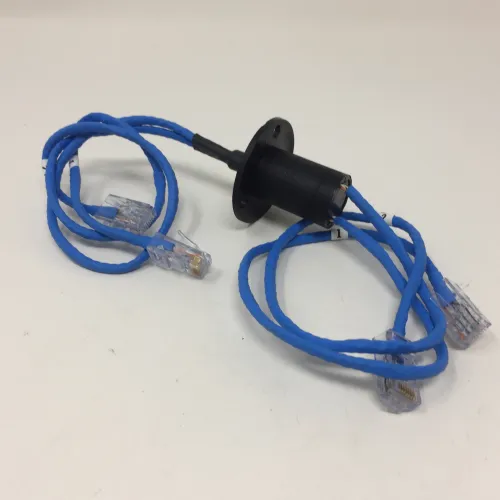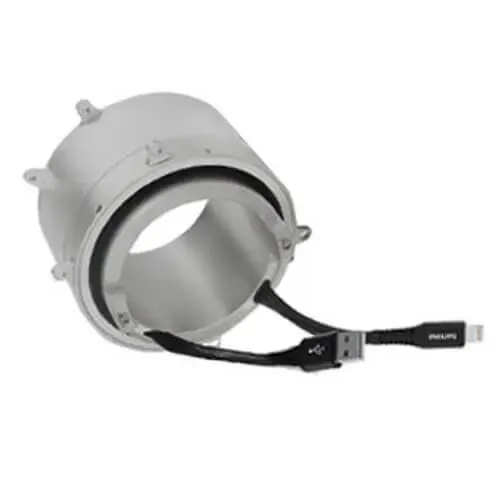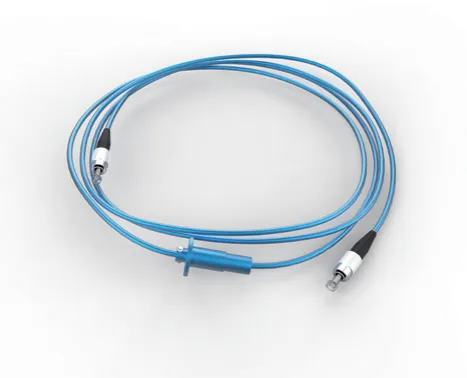Slip Ring Data Transmission Technologies (Ethernet, USB)
BY NBG
 2025-10-28
2025-10-28
VIEWS: 158

Slip Ring Data Transmission Technologies (Ethernet, USB)
Transmission of high-speed data over a rotating interface comes with a lot of challenges like signal loss, cable tangles, and even mechanical wear and tear. Slip rings can solve these issues, supporting continuous Ethernet or USB transmission.
The blog below explores technical concerns and also compares Ethernet Vs USB slip ring designs and the best practices that can help with future data transmission.
Slip Rings In A Rotational World
A slip ring is an electrical device that rotates continuously at 360 degrees and transmits signals and power between the rotating rotor and the stationary stator.
It was developed for basic transfer of power initially, but now modern slip rings support multi-signal transmissions. These may comprise encoder pulses, control signals, fiber optics, USB, and Ethernet.


The use of such versatile components is crucial in such applications where rotation and connectivity are required. Ranging from robotic arms to CT scanners, CCTV units, and wind turbines, slip rings allow a seamless data flow and support mobility and precision.
Why High‑Speed Data Transmission Still Matters
High-speed data transmission is one of the crucial things that is required for a lot of reasons by different applications. Some of the reasons that support its significance are as follows:
Popular Ethernet & USB interfaces:
High-speed interfaces like 10/100/1000 Base-T Ethernet and USB 2.0/3.0 are standard in modern devices. They are very critical in applications like automation, where they support diagnostics and control, in robotics for sensor feedback, in medical imaging for image transfer, and in surveillance for streaming high-resolution data. Such an interface helps support reliability, speed, and integration.
Rotation without wires
Incorporating slip rings for data transmission helps prevent the requirement of fixed cables that wear out with time, and also limits rotation.
The continuous 360-degree rotation with no wire tangling reduces the fragility of the system and makes maintenance simple, ensuring uninterrupted operation. It is crucial in rotating scanners, robotic arms, and camera turrets that work non-stop.
Bandwidth needs rising
The systems these days depend on large data streams and real-time communication. The multi-megapixel camera, motion control with live feedback, and industrial Ethernet protocols need stable and high-bandwidth links. Slip rings can handle the gigabit speeds and allow engineers to come up with more data-rich and capable rotating platforms.
Technical Challenges: Why Data Slip Rings Are Not “Just Wires”
Transmission of high-speed data through a rotating interface is very complex compared to basic wires. Slip rings need to meet strict environmental, mechanical, and electrical criteria for maintaining signal integrity when in continuous movement.
Transmission‑line demands:
High-speed data protocols like Gigabit Ethernet have some stringent electrical requirements. Slip rings must ensure consistent 100-ohm differential impedance, minimal return loss, low insertion loss, and crosstalk.
It is also important for them to offer performance of twisted pair cables through a wide range of frequencies, as a slight mismatch can also reduce the signal's distortion.
Contact noise & BER:
Slip rings depend on metal brushes that slide against conductive rings, such that physical contact creates microvolt-level electrical noise. This noise can disrupt the balance of differential signals in USB or Ethernet, which increases the data loss risk.
In order to deal with this issue, gold plating or fiber brushes are used so that the interface is reduced and constant stability is achieved.
EMI and environmental factors:
Inside large equipment such as CT scanners, there are many complex electrical systems, which bring complex electromagnetic environment. The design of slip ring needs to resist electromagnetic interference, ensure the stability of data transmission, and avoid the occurrence of errors.Meanwhile, some applications of slip rings need to face various environmental challenges, such as dust, vibration, salt spray and temperature fluctuations. Proper sealing, material selection and contact design are critical for the stable data and current transmission of slip rings.
Rotation speed, lifespan & wear:
Continuous rotation with hundreds to thousands RPM leads to wear and tear on contact brushes, which impacts performance with time. In order to ensure signal integrity and long life, high-quality slip rings use precious metal contacts that are low-friction and are meant for Tens even Hundreds of millions of revolutions following consistent conductivity.
Ethernet Slip Rings: From 100Base‑T to Gigabit and Beyond
Ethernet over slip rings is not about connecting the RJ45 jacks only; it needs proper engineering so that a reliable and high-speed transmission is carried out through rotating interference. Front 100 Base-T to industrial grade Gigabit links, every level presents unique challenges in signal integrity and offers protocol compatibility.
Standard variants:
Gigabit capability (1000Base‑T):
Gigabit Ethernet needs advanced slip ring designs with shielded twisted pairs, low resistance precious metal contacts, and impedance control. Models like D & SS/D
Services and others from Moog or NBG maintain PROFINET, EtherNet/IP, and EtherCAT performance despite vibration and continuous rotation.
Single‑pair solutions:
Emerging standards like 1000BASE-T1 and 100BASE-T1 are used in sensors and automotive networks, which use one pair of wires. Slip rings maintain an impedance of 100 Ω throughout rotation, creating a new design challenge for lightweight and compact systems.
Educational note:
crosstalk, return loss, and insertion loss are core metrics that determine Ethernet performance in slip rings. In the absence of tight tolerance in such areas, achieving reliability of a gigabit is unlikely.
Protocol compatibility:
As long as the physical layer is preserved Ethernet slip rings can support Powerlink, EtherCAT, and other industrial protocols. These ensure that electrical performance allows for protocol functionality in rotating systems.
USB Slip Rings: Handling USB 2.0 vs USB 3.0
USB 2.0 capability:
USB 2.0 slip rings are very reliable and common, but handling USB 3.0 at 5 Gbps comes with a design complexity. High-speed USB needs precision for maintaining signal quality so that low bit rate errors are ensured.
High-end solutions:
Advanced models of NBG are meant for USB 3.0 that support multiple channels along with signal and power lines using hard-gold contacts, engineering impedance control, and optimized shielding to reduce bit error rate and maintain signal integrity.
Connector options & backward compatibility:
Slip rings can have varied USB connectors like Type A, Type B, Micro USB, or USB-C. When it comes to full speed operation, the host and device need to support the target version of USB, and the ring must ensure that it maintains signal paths.
Hybrid Designs: Data + Power, PoE, Signals (Encoder, CANbus, RS‑485)
Hybrid slip rings transmit USB or Ethernet along with encoder signals, power, CANbus, thermocouples, and RS-485 in one compact unit. Designs from NBG support PoE, allowing data and power through a single channel. It is suitable for surveillance, automation, and robotics requiring high reliability in rotating systems.
When Copper Isn’t Enough: Fiber‑Optic Rotary Joints (FORJs)

Why go optical?
Copper slip rings have a limited bandwidth, and they are vulnerable to EMI. Fiber-optic rotary joints can overcome these issues, allowing data rates of 10 Gbps with proper immunity to electrical noise, making it suitable for fast and high-reliability systems.
Design trade‑offs:
FORJs offer seamless performances but have some trade-offs as they are highly expensive and need precision-oriented optical alignment. Hence, due to their complexity, they are reserved for applications that are meant for critical missions or have high bandwidth.
Hybrid fibre‑copper combos:
Most of the advanced systems integrate fiber-optic channels for high-speed data, followed by copper rings for control and power signals. These hybrid assemblies allow one rotating interface to look after electrical as well as communication needs. It improves system performance and space efficiency at the same time.
When to choose FORJ:
FORJ is suitable when signal integrity and bandwidth cannot be negotiated, like in radar systems. The FORJ works seamlessly in environments that have high EMI or where data fidelity requires preservation under constant rotation.
Conclusion:
Slip rings are crucial for power transmission and reliable data in rotating systems. Ranging from USB to Ethernet, every technology is meant to serve specific requirements. Hence, understanding the capabilities and challenges allows engineers to select the right solution, balancing signal integrity, durability, and speed in high-performance applications.








